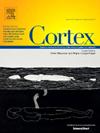半球专门化在决定伪忽视中的次要作用:一项预先登记的复制扩展研究。
IF 3.2
2区 心理学
Q1 BEHAVIORAL SCIENCES
引用次数: 0
摘要
神经系统完整的个体在空间注意力上表现出轻微的不对称性,这可以在实验空间任务(如平分线)中测量到。尽管这种被称为“伪忽略”的现象传统上被解释为右半球主导视觉空间注意力的结果,但大量证据表明,这不是唯一的决定因素,甚至不是最重要的决定因素。例如,最近一项针对左撇子的功能磁共振成像研究显示,尽管与典型的偏侧对照(N = 40)相比,他们的空间偏见不那么明显,但具有左半球反向优势的罕见个体(LHDS, N = 23)也表现出左侧假性忽视。目前的研究试图在更广泛的右撇子(N = 75)和左撇子(N = 181)队列中复制和扩展这些发现,同时解决原始研究的方法局限性。与半球专业化解释的预测相反,LHDS参与者的伪忽略并未逆转(N = 49)。然而,与典型脑偏侧的对照组(N = 207)相比,由于LHDS组的伪忽视在人群水平上的随机化,伪忽视效应有所降低。这些结果与原始研究的结果一致,支持伪忽略的多因素解释,半球专业化是许多决定因素之一,而不是主要原因。本文章由计算机程序翻译,如有差异,请以英文原文为准。
A minor role for hemispheric specialization in determining pseudoneglect: A pre-registered replication-extension study
Neurologically intact individuals display a mild asymmetry in spatial attention that can be measured during experimental spatial tasks such as line bisection. Although this phenomenon, known as pseudoneglect, is traditionally explained as the consequence of right hemisphere dominance for visuospatial attention, surmounting evidence suggests this is not its sole or even its most important determinant. For instance, a recent fMRI study in left-handers revealed that rare individuals with a reversed, left hemispheric dominance (LHDS, N = 23) also demonstrated left-sided pseudoneglect, although their spatial bias was less marked compared to typically lateralized controls (N = 40). The current study sought to replicate and extend these findings in a broader cohort of right-handers (N = 75) and left-handers (N = 181), while addressing methodological limitations of the original study. Contrary to the predictions of the hemispheric specialization account, pseudoneglect was not reversed in LHDS participants (N = 49). However, the pseudoneglect effect was reduced compared to controls with typical cerebral laterality (N = 207) due to a population-level randomization of pseudoneglect in the LHDS group. These results align with those of the original study, supporting a multifactorial interpretation of pseudoneglect, with hemisphere specialization as one among many determinants rather than being the predominant cause.
求助全文
通过发布文献求助,成功后即可免费获取论文全文。
去求助
来源期刊

Cortex
医学-行为科学
CiteScore
7.00
自引率
5.60%
发文量
250
审稿时长
74 days
期刊介绍:
CORTEX is an international journal devoted to the study of cognition and of the relationship between the nervous system and mental processes, particularly as these are reflected in the behaviour of patients with acquired brain lesions, normal volunteers, children with typical and atypical development, and in the activation of brain regions and systems as recorded by functional neuroimaging techniques. It was founded in 1964 by Ennio De Renzi.
 求助内容:
求助内容: 应助结果提醒方式:
应助结果提醒方式:


